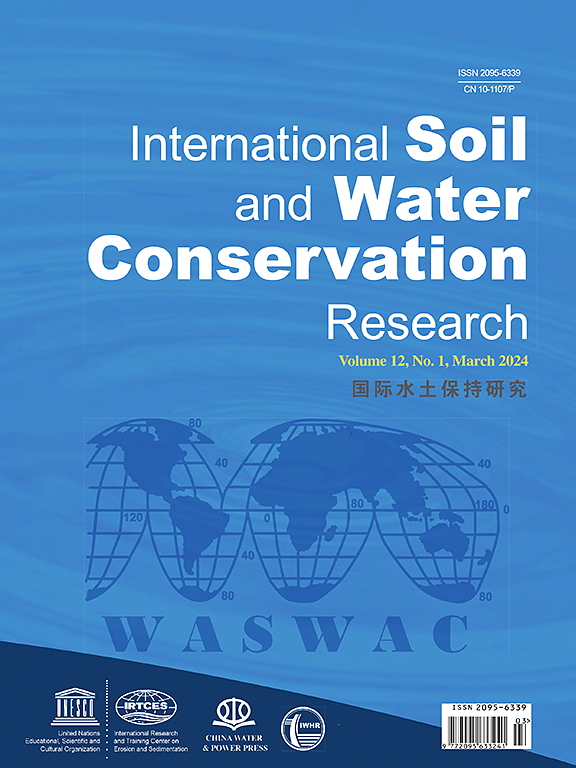Impacts of topography on the morphological indices of ephemeral gullies in the Chinese mollisol region
IF 7.3
1区 农林科学
Q1 ENVIRONMENTAL SCIENCES
International Soil and Water Conservation Research
Pub Date : 2024-11-22
DOI:10.1016/j.iswcr.2024.11.003
引用次数: 0
Abstract
Ephemeral Gully (EG) erosion is a main erosion type on sloping croplands in the Chinese Mollisol region, causing severe land degradation and crop yield reduction, but how topographic factors, such as slope gradient, slope aspect, and upslope and lateral drainage areas, affect the morphological indices of EGs is still unclear. Thus, this study applied a high-resolution 5-cm Digital Elevation Model (DEM) obtained from Unmanned Aerial Vehicles (UAV) aerial surveys to quantify the impacts of topography on the morphological indices of EGs in a typical Mollisol region located in Keshan County, Heilongjiang Province. The results showed that the length of EGs decreased with an increase in slope gradient or increased with an increase in upslope and lateral drainage areas. The distribution density, dissected degree, and vertical gradient of EGs increased with an increase in slope gradient or a decrease in the upslope and lateral drainage areas. Moreover, 10 ha and 5 ha areas were critical values regarding the impacts of the upslope drainage area and lateral drainage area on the width, depth, and volume of EGs, respectively, and 0.11 m m−1 and 0.03 m m−1 were critical values regarding the impacts of slope gradients of the upslope drainage area and lateral drainage area on the width, depth, and volume of EGs, respectively. In addition, the number of EGs on sunny and semi-sunny slopes was 1.8 times higher than that on shady and semi-shady slopes. In particular, the topographic thresholds of EG occurrence, synthesizing upslope and lateral gradients, and upslope and lateral drainage areas, were determined, overcoming the current research deficiency of considering only the upslope drainage area and ignoring the lateral drainage area. The results provide an important basis for understanding EG erosion development and implementing precise soil conservation measures.
地形对中国软土层地区短命沟形态指标的影响
短期沟壑侵蚀是中国Mollisol地区坡耕地的主要侵蚀类型,造成严重的土地退化和作物减产,但坡度、坡向、上、侧向流域等地形因素对短期沟壑侵蚀形态指标的影响尚不清楚。因此,本研究利用无人机(UAV)航测获得的高分辨率5厘米数字高程模型(DEM),量化了地形对黑龙江省克山县典型Mollisol地区EGs形态指标的影响。结果表明:随着坡面坡度的增大,坡面长度减小,随着坡面和侧向排水面积的增大,坡面长度增大;EGs分布密度、解剖程度和垂直梯度随坡度的增大而增大,在上坡和侧向排水区呈减小趋势。10 ha和5 ha面积分别是上坡流域和侧坡流域对EGs宽度、深度和体积影响的临界值,0.11 m m−1和0.03 m m−1分别是上坡流域和侧坡流域坡度对EGs宽度、深度和体积影响的临界值。阳坡和半阳坡上的茄子数量是阴坡和半阴坡上茄子数量的1.8倍。特别是综合上坡和侧向坡度、上坡和侧向流域,确定了EG发生的地形阈值,克服了目前研究中只考虑上坡流域而忽略侧向流域的不足。研究结果为了解土壤侵蚀的发展规律和实施精准的水土保持措施提供了重要依据。
本文章由计算机程序翻译,如有差异,请以英文原文为准。
求助全文
约1分钟内获得全文
求助全文
来源期刊

International Soil and Water Conservation Research
Agricultural and Biological Sciences-Agronomy and Crop Science
CiteScore
12.00
自引率
3.10%
发文量
171
审稿时长
49 days
期刊介绍:
The International Soil and Water Conservation Research (ISWCR), the official journal of World Association of Soil and Water Conservation (WASWAC) http://www.waswac.org, is a multidisciplinary journal of soil and water conservation research, practice, policy, and perspectives. It aims to disseminate new knowledge and promote the practice of soil and water conservation.
The scope of International Soil and Water Conservation Research includes research, strategies, and technologies for prediction, prevention, and protection of soil and water resources. It deals with identification, characterization, and modeling; dynamic monitoring and evaluation; assessment and management of conservation practice and creation and implementation of quality standards.
Examples of appropriate topical areas include (but are not limited to):
• Conservation models, tools, and technologies
• Conservation agricultural
• Soil health resources, indicators, assessment, and management
• Land degradation
• Sustainable development
• Soil erosion and its control
• Soil erosion processes
• Water resources assessment and management
• Watershed management
• Soil erosion models
• Literature review on topics related soil and water conservation research
 求助内容:
求助内容: 应助结果提醒方式:
应助结果提醒方式:


